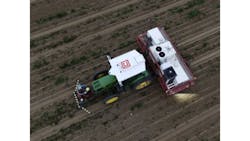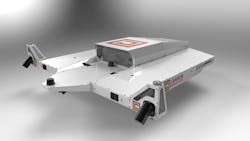Carbon Robotics Launches Autonomous Tractor Kit
Carbon Robotics (Seattle, WA, USA) recently launched a kit to turn standard tractors into autonomous machines monitored remotely.
Although the tractors traverse fields without a human onboard, trained personnel at a remote operations center monitor the tractors while they are operating and handle human interventions as needed. For example, a tractor might stop suddenly if an unexpected obstruction is in its path, such as a coyote or an irrigation pipe. With the remote team handling stoppages and other issues, farmers are free to work on other projects.
The autonomy kit, Carbon AutoTractor, is initially compatible with the John Deere (Moline, IL, USA) 6R and 8R Series tractors and can be installed on-site by a Carbon Robotics’ field support employee in less than 24 hours. Once installation is complete, the tractors can toggle between manual and autonomous operation. Farmers push a control button to engage autonomous operations.
Indeed, Deere & Company, which markets itself as John Deere, also has moved into the autonomy space. The company launched its first autonomous machine, a tractor for tillage, in 2022. Earlier this year, John Deere unveiled additions to its autonomous fleet including machines designed for work in orchards, quarry operations, and commercial lawn mowing.
Related: John Deere Unveils New Autonomous Machines
For its autonomy solution, Carbon Robotics developed a mobile app for a tablet or phone that allows farmers to monitor the progress of a tractor as it moves through a field. If they install a camera from Carbon Robotics on the equipment attached to the tractor, they also can monitor the progress of a job, such as tilling, plowing, or mowing. The view farmers see via the app is a map of the field comprised of satellite image tiles.
Currently, tractors equipped with the autonomy kit are operating at commercial farms, although Carbon Robotics CEO Paul Mikesell didn't say how many are doing so. "We are continuing to ship new equipment every day,” he adds.
The Machine Vision Setup
The autonomy system that sits on top of the tractor includes RTK-accurate GPS, machine vision cameras facing in each direction, radar-based safety sensors, and physical bumper bars—all connected via a high-speed, low-latency satellite link.
The components are mounted inside or on top of an enclosure that sits on the hood of a tractor.
Related: Harvesting the Benefits of Autonomous Agricultural Machinery
To drive the vehicle autonomously, a convolutional neural network developed by Carbon Robotics processes images and directs the tractor’s path along the furrows between rows of crops.
“So, our neural net is figuring out where the furrow is and keeping the wheel in that furrow. And then there's another neural net running that's just doing general object detection on the things it sees in the camera to make sure that there's no unexpected, weird things showing up in the field,” Mikesell says.
Related: Weed Control System Uses Robotic Dog, Machine Vision, and Flamethrower
RGB images taken from cameras inform the CNN navigating the furrow. For object detection and situational awareness, the second algorithm also uses 3D point cloud data, Mikesell says.
The LaserWeeder
The tractor is the company’s second machine. Carbon Robotics also sells a machine to kill weeds with lasers, and the company launched the latest generation, LaserWeeder G2, in February 2025.
LaserWeeder is designed to be pulled by tractors augmented with AutoTractor as well as other tractors.
Using convolutional neural networks trained on a database of 40 million plants, LaserWeeder distinguishes crops from weeds and then targets weeds with sub-millimeter precision.
There are two neural nets: one for detecting weeds and the second for targeting weeds with one of two 240W lasers.
Each weeding module also includes three machine vision cameras, 20 LED lights, and two GPUs from Nvidia (Santa Clara, CA, USA) in an embedded computing device. Different models of the LaserWeeder have varying numbers of weeding modules.
Related: Rotor Technologies Developing Giant Ag Drone
Lighting is a particularly important piece of the machine vision system for LaserWeeder because of the need to target weeds—not crops. “We have a very finely controlled, very high intensity strobing system that is connected directly to the cameras on the laser weeder, and there's one shutter signal that controls all the lights and all the cameras at the same time,” Mikesell says.
About the Author
Linda Wilson
Editor in Chief
Linda Wilson joined the team at Vision Systems Design in 2022. She has more than 25 years of experience in B2B publishing and has written for numerous publications, including Modern Healthcare, InformationWeek, Computerworld, Health Data Management, and many others. Before joining VSD, she was the senior editor at Medical Laboratory Observer, a sister publication to VSD.



